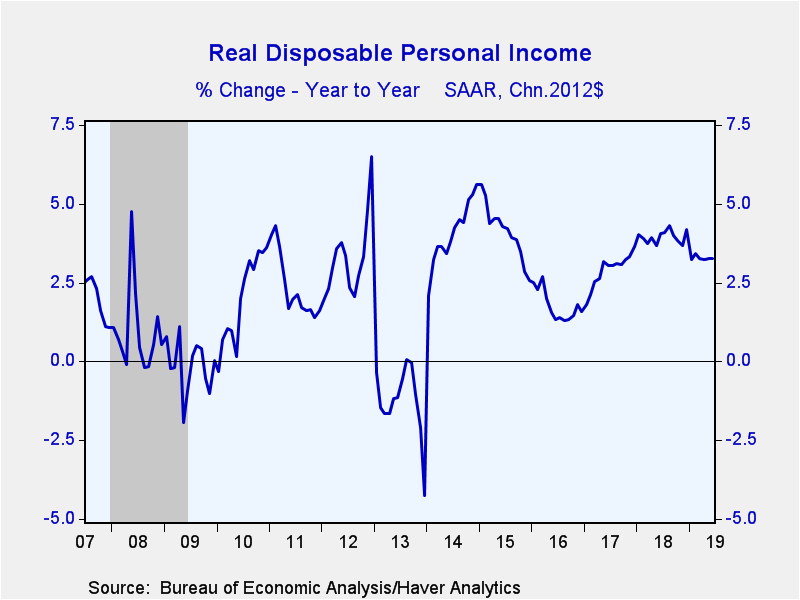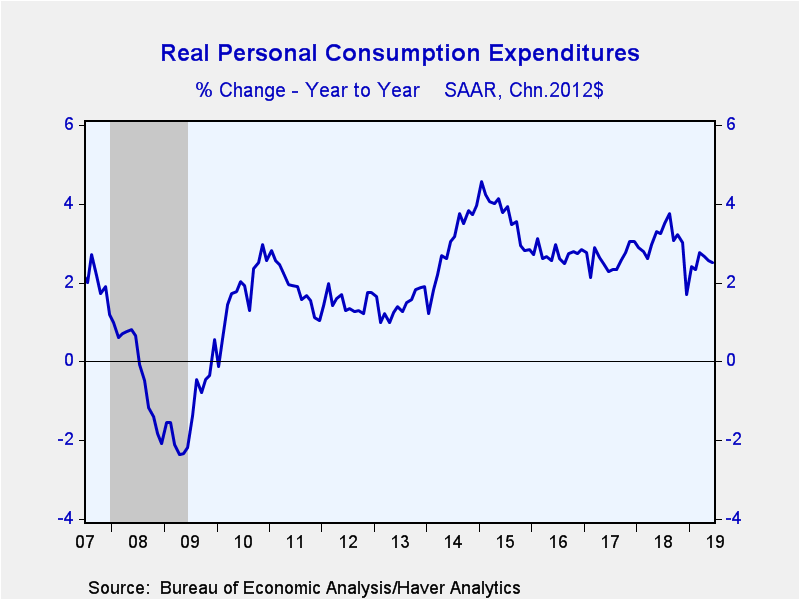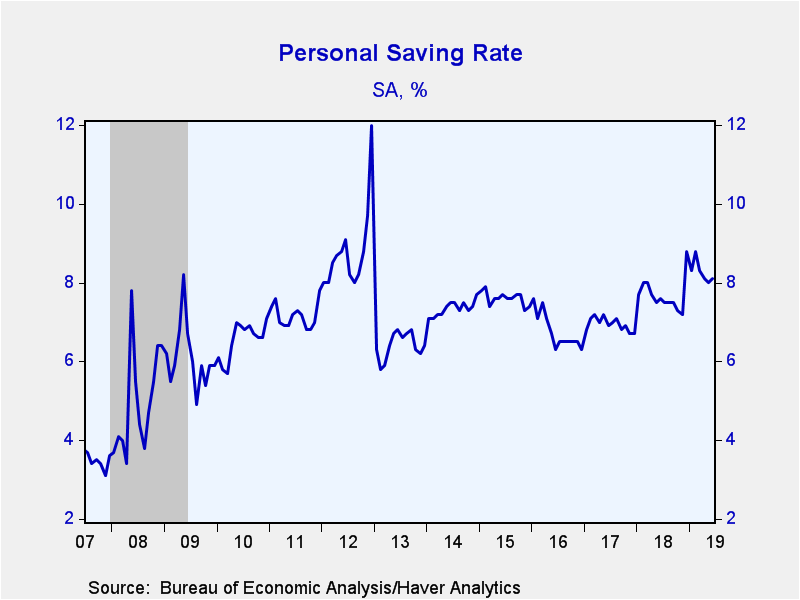 Global| Jul 30 2019
Global| Jul 30 2019U.S. Personal Income & Spending Increase Moderately; Revisions Reveal More Saving
by:Tom Moeller
|in:Economy in Brief
Summary
Personal income increased 0.4% (4.9% y/y) during June for the fourth consecutive month. May was revised from 0.5%. A 0.3% rise had been expected in the Action Economics Forecast Survey. Revisions indicate more income growth in 2018 [...]
Personal income increased 0.4% (4.9% y/y) during June for the fourth consecutive month. May was revised from 0.5%. A 0.3% rise had been expected in the Action Economics Forecast Survey. Revisions indicate more income growth in 2018 and 2017 than reported earlier. Wages & salaries increased 0.5% (5.5% y/y) after a 0.2% gain. Earlier growth was revised up. Proprietors income improved 0.4% (3.7% y/y) after a 0.7% rise. Rental income improved 0.6% (3.4% y/y), the strongest increase in 12 months. Receipts on assets rose 0.3% (3.4% y/y) following downwardly-revised monthly gains. A 0.5% gain (3.6% y/y) in interest income was accompanied by little change in dividend earnings (3.1% y/y) which followed a 0.1% uptick. Personal transfer receipts increased 0.4% (6.6% y/y) for the third month in the last four. Medicare receipts surged another 0.7% (10.0% y/y). Income from Social Security rose 0.2% (6.4% y/y) for a third straight month, and Medicaid receipts firmed 0.5% (4.7% y/y). Earlier Medicaid increases were revised up significantly. Jobless insurance income improved 0.8% (-2.6% y/y).
Disposable income grew 0.4% last month after a 0.3% gain, revised from 0.5%. Growth last year was revised to 6.1% from 4.9%. Growth during 2017 was increased to 4.7% from 4.4%. When adjusted for higher prices, take-home pay increased 0.3% (3.3% y/y), the firmest rise in four months.
Personal consumption expenditures increased 0.3% during June following a 0.5% May gain, revised from 0.4%. A 0.3% increase had been expected. Growth during all of last year was revised to 5.2% from 4.7%, and growth in 2017 was lifted to 4.4% from 4.3%. Durable goods spending improved 0.4% (4.0% y/y) after a 1.5% jump. It reflected a 1.1% strengthening (6.1% y/y) in spending on recreational goods & vehicles which followed a 1.5% increase. A 0.7% (3.6% y/y) increase in furniture & home appliance sales was the fourth straight month of strong gain. Offsetting these increases was a 0.4% dip (+3.4% y/y) in motor vehicle buying which followed a 2.2% jump. Spending on nondurable goods edged 0.2% higher (3.1% y/y) after a 0.1% uptick. A 2.8% decline (-5.8% y/y) in spending on gasoline & other energy products held back the increase as prices fell. Apparel purchases rose 0.6% (2.4% y/y) following a 0.3% rise. Foods & beverage purchases rose 0.7% (3.5% y/y) following a 0.3% gain. Outlays on services rose a moderate 0.3% (4.1% y/y), the weakest rise in four months. Health care spending rose 0.2% (4.5% y/y) and outlays on transportation services gained 0.3% (2.3% y/y) for a second straight month. Offsetting these increases, recreation services spending eased 0.1% (+2.8% y/y) y/y) and added to May's 0.2% decline. Housing & utilities outlays fell 0.2% (+3.7% y/y) following a 0.5% rise.
After adjustment for price inflation, personal consumption expenditures increased 0.2% (2.5% y/y), the weakest increase in four months. Real spending during all of last year was revised to 3.0% from 2.6%, and growth in 2017 was raised minimally to 2.6%.
Consumers have been in a mood to save, and saved more than was indicated in earlier data. The personal savings rate increased slightly to 8.1% last month from 8.0%, but remained below its February peak of 8.8%. During all of last year, however, the personal savings rate was revised to 7.7% from 6.7%. The 2017 savings rate also was revised up to 7.0% from 6.7%. The level of personal savings increased 12.5% y/y during June.
The PCE chain price index inched 0.1% higher after a downwardly-revised 0.1% May increase. The 1.4% y/y increase was below the 2.5% y/y peak last July. The price index excluding food & energy increased a steady 0.2%. The 1.6% y/y gain was below the 2.1% peak last July. Nondurable product prices declined 0.4% last month (-0.6% y/y) as fuel prices fell. The services price index rose a steady 0.2% (2.2% y/y). The durable goods price index rose 0.5% (-0.5% y/y) following a 0.1% uptick.
The personal income and consumption figures are available in Haver's USECON database with detail in the USNA database. The Action Economics figures are in the AS1REPNA database
Tom Moeller
AuthorMore in Author Profile »Prior to joining Haver Analytics in 2000, Mr. Moeller worked as the Economist at Chancellor Capital Management from 1985 to 1999. There, he developed comprehensive economic forecasts and interpreted economic data for equity and fixed income portfolio managers. Also at Chancellor, Mr. Moeller worked as an equity analyst and was responsible for researching and rating companies in the economically sensitive automobile and housing industries for investment in Chancellor’s equity portfolio. Prior to joining Chancellor, Mr. Moeller was an Economist at Citibank from 1979 to 1984. He also analyzed pricing behavior in the metals industry for the Council on Wage and Price Stability in Washington, D.C. In 1999, Mr. Moeller received the award for most accurate forecast from the Forecasters' Club of New York. From 1990 to 1992 he was President of the New York Association for Business Economists. Mr. Moeller earned an M.B.A. in Finance from Fordham University, where he graduated in 1987. He holds a Bachelor of Arts in Economics from George Washington University.










